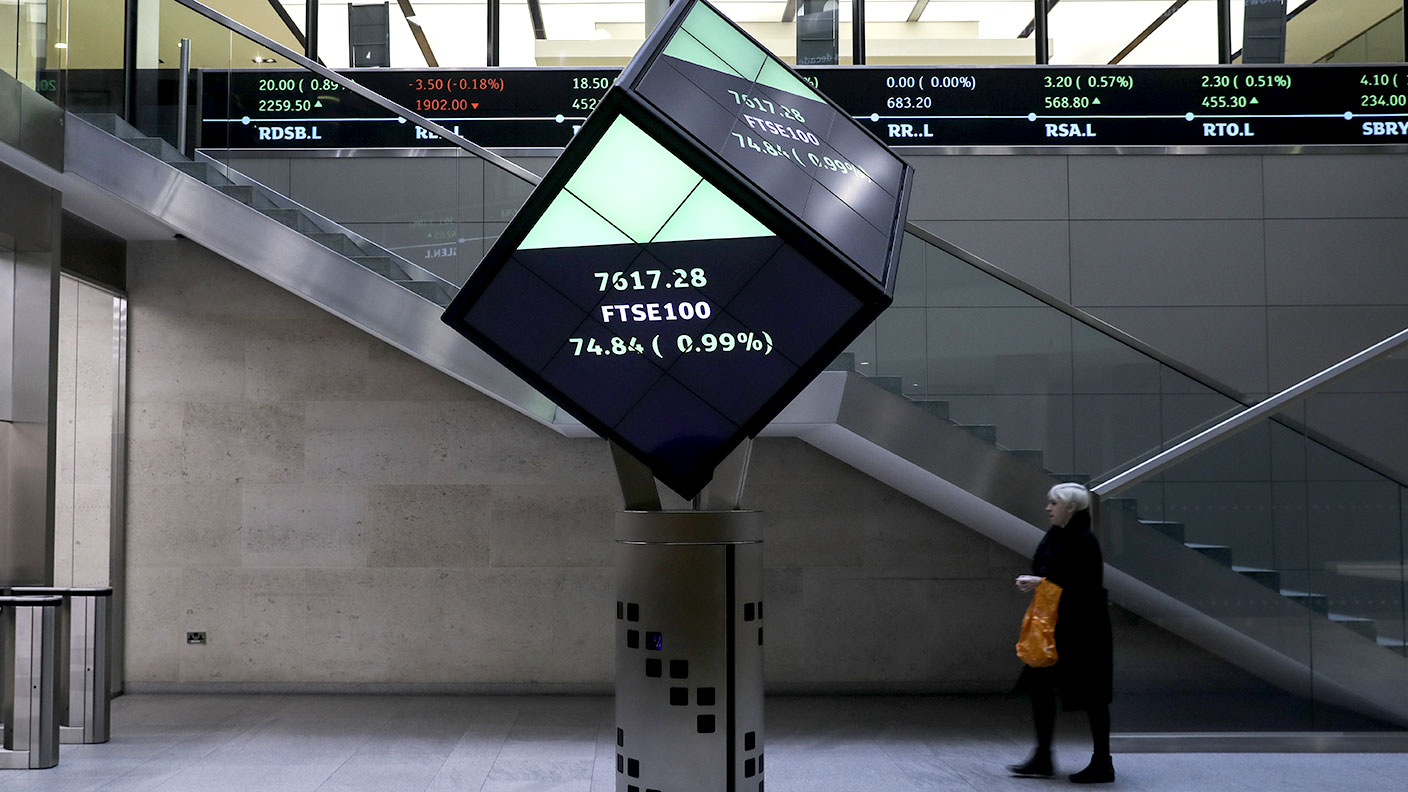A simple way to profit from the next big trend change in the markets
Change is coming to the markets as the tech-stock bull market of the 2010s is replaced by a new cycle of rising commodity prices. John Stepek explains how to take advantage.


Markets are suffering from “intense cognitive dissonance” right now, as Vincent Deluard of StoneX puts it. On the one hand, everyone's getting excited about re-opening. You've got energy stocks rallying and commodity prices perking up. Yet on the other hand, the “work-from-home” stocks and the “death of fossil fuels” stocks are still doing well.
And while inflation and devaluation hedges such as bitcoin are soaring, interest rates remain low too. Almost everything is going up. What does it all mean? According to Deluard, it means a change is coming fast.
We might be facing a new cycle of rising commodity prices
Markets currently seem to be struggling to choose between two somewhat conflicting narratives. One is that the Covid pandemic has merely accelerated our move along an existing trend: tech will take over our lives even further than it already has; interest rates and inflation will remain quiescent due to debt, demographics and disruption. Central bank and government money is welcome, but it's just more fodder for asset price inflation.
MoneyWeek
Subscribe to MoneyWeek today and get your first six magazine issues absolutely FREE

Sign up to Money Morning
Don't miss the latest investment and personal finances news, market analysis, plus money-saving tips with our free twice-daily newsletter
Don't miss the latest investment and personal finances news, market analysis, plus money-saving tips with our free twice-daily newsletter
The other is that we'll rebound sharply out of the pandemic. Demand will recover, the economy will grow sharply, and inflation will put pressure on central banks to the point where their only choice will be to either raise interest rates (and risk the recovery) or to suppress rates artificially, thus fuelling even more inflation.
Both of these scenarios can't be right. And they both have very different implications for portfolios. But markets don't seem to be able to make up their minds. Instead, they're sending the price of most things higher. So what's going on?
Vincent Deluard of StoneX points out that “such confusion is not unusual at inflection points”. He notes that if you compare performance of key sectors on a relative basis, then a clear shift has already happened. The “big trends of the 2010s (Nasdaq versus small caps, technology versus value, and the US versus international markets) peaked on September 1st” last year. That suggests that “the next five years should resemble the 2002-07 period”. In other words, we're looking at a shift away from the tech bubble and towards a period of rising commodity prices and increased inflationary pressure.
For now, it feels as though the market consensus is that this is a “good thing”. We'll get reflation and recovery, but only to an extent that is positive for stocks, not too painful for bonds, and everyone can carry on as normal. I think this is where the market is in wishful thinking mode. The risk is that inflation will be more serious and harder to cope with than investors expect. Rising commodity prices are a pressure that companies could do without. But the big difference is that they might be able to pass these costs onto consumers now.
This goes back to what we've been discussing regularly in MoneyWeek – the unusual macroeconomic impact of the coronavirus. You've had a massive demand hit in some sectors. But that's only because people have been confined to quarters. This is totally different to a more traditional recession or financial crisis, where demand drops off simply because people essentially run out of money (because banks stop lending or there are huge job losses or both).
So you have genuinely pent-up demand. Then, on the supply side, you have the demolition of weaker companies in the hardest-hit sectors, which reduces competition and boosts the pricing power of the dominant players. You also have supply bottlenecks, as demand rebounds and takes producers by surprise. I wrote on Tuesday about what's happening in the global energy market as a nasty winter takes hold in Asia. But it's not just natural gas and the like. Food prices are surging too.
An easy way to get exposure to the next big shift in markets
Some investors are still assuming that this is just a rebound from the lows of last year – so while we'll see inflation, it's just a passing phenomenon, driven by “base effects” (ie, last year was so low that any rebound this year will make inflation look high).
But I'm not so sure. As John Authers points out in his latest Bloomberg newsletter, Jim Reid at Deutsche Bank notes that the S&P 500 hasn't been this expensive relative to raw material prices since at least 1916 (because that's as far back as his chart goes, not because raw material prices were especially high back then).
Along with everything else that's going on, that indicates to me that we're ripe for a turn. Or at least, that it would make sense for your portfolio to prepare for such a turn. What's an easy way to do it? Believe it or not, a simple method of getting exposure to a change of trend lies very close to home for UK investors.
As Bryce Elder notes in the FT, “so-called value sectors such as banking, energy and materials... account for 40% of the FTSE 100 by weight”. Meanwhile, the tech sector makes up just 1% of the UK's lead index. That explains why it's done so badly in recent years. Brexit uncertainty hasn't helped, and it's given global fund managers an easy excuse to avoid the UK. But the heavy weighting towards the most detested sectors and away from the most well-loved ones has been a far greater influence.
However, this also leaves the UK index looking very well positioned to take advantage of any shift in the macroeconomic environment. So if you're looking to get exposure to the most undervalued bits of the market right now, while avoiding the most bubbly, you could do a lot worse than simply buy a FTSE 100 tracker.
We have looked at various other more specific UK investments that could do well from the reflation trade in MoneyWeek magazine in recent issues. We'll no doubt be revisiting the topic again soon.
Meanwhile, this week we're talking about the bubbly US stockmarket. The cover shows Elon Musk juggling bitcoins while riding a unicorn. I'm not joking. If you're not already a subscriber, sign up and get your first six weekly issues free here.
Get the latest financial news, insights and expert analysis from our award-winning MoneyWeek team, to help you understand what really matters when it comes to your finances.
John Stepek is a senior reporter at Bloomberg News and a former editor of MoneyWeek magazine. He graduated from Strathclyde University with a degree in psychology in 1996 and has always been fascinated by the gap between the way the market works in theory and the way it works in practice, and by how our deep-rooted instincts work against our best interests as investors.
He started out in journalism by writing articles about the specific business challenges facing family firms. In 2003, he took a job on the finance desk of Teletext, where he spent two years covering the markets and breaking financial news.
His work has been published in Families in Business, Shares magazine, Spear's Magazine, The Sunday Times, and The Spectator among others. He has also appeared as an expert commentator on BBC Radio 4's Today programme, BBC Radio Scotland, Newsnight, Daily Politics and Bloomberg. His first book, on contrarian investing, The Sceptical Investor, was released in March 2019. You can follow John on Twitter at @john_stepek.
-
 ‘Why I have ditched my Help to Buy ISA for cash savings and the stock market’
‘Why I have ditched my Help to Buy ISA for cash savings and the stock market’Without the 25% bonus, my Help to Buy ISA is effectively redundant, says MoneyWeek writer Sam Walker.
-
 Is your inheritance tax allowance cut if you sell to downsize or sell your home to pay for care?
Is your inheritance tax allowance cut if you sell to downsize or sell your home to pay for care?Downsizing relief is a little-known benefit that could save your loved ones tens of thousands of pounds in inheritance tax after you’ve died.
-
 Halifax: House price slump continues as prices slide for the sixth consecutive month
Halifax: House price slump continues as prices slide for the sixth consecutive monthUK house prices fell again in September as buyers returned, but the slowdown was not as fast as anticipated, latest Halifax data shows. Where are house prices falling the most?
-
 Rents hit a record high - but is the opportunity for buy-to-let investors still strong?
Rents hit a record high - but is the opportunity for buy-to-let investors still strong?UK rent prices have hit a record high with the average hitting over £1,200 a month says Rightmove. Are there still opportunities in buy-to-let?
-
 Pension savers turn to gold investments
Pension savers turn to gold investmentsInvestors are racing to buy gold to protect their pensions from a stock market correction and high inflation, experts say
-
 Where to find the best returns from student accommodation
Where to find the best returns from student accommodationStudent accommodation can be a lucrative investment if you know where to look.
-
 The world’s best bargain stocks
The world’s best bargain stocksSearching for bargain stocks with Alec Cutler of the Orbis Global Balanced Fund, who tells Andrew Van Sickle which sectors are being overlooked.
-
 Revealed: the cheapest cities to own a home in Britain
Revealed: the cheapest cities to own a home in BritainNew research reveals the cheapest cities to own a home, taking account of mortgage payments, utility bills and council tax
-
 UK recession: How to protect your portfolio
UK recession: How to protect your portfolioAs the UK recession is confirmed, we look at ways to protect your wealth.
-
 Buy-to-let returns fall 59% amid higher mortgage rates
Buy-to-let returns fall 59% amid higher mortgage ratesBuy-to-let returns are slumping as the cost of borrowing spirals.
